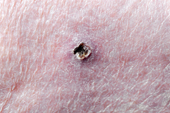Squamous cell carcinoma, also known as SCC, is a very common type of skin cancer, second only to basal cell carcinoma. Approximately 700,000 new incidences of squamous cell carcinoma are diagnosed every year in America causing approximately 2,500 deaths. Find out what you can do to protect yourself from this form of skin cancer.
What is Squamous Cell Carcinoma?
This form of skin cancer occurs only in the squamous cells, which are the majority of the skin’s upper layers (called the epidermis). Squamous cell carcinoma (SCC) is a proliferation of atypical skin cells. This type of skin cancer is generally caused by the cumulative effects of exposure to ultraviolet (UV) radiation over the course of a person’s life. It can disfigure an individual and sometimes becomes deadly, when allowed to progress without proper treatment.
SCCs can occasionally occur in areas like the genitals and mucous membranes. The most common spots are the areas that are overexposed to the harmful UV rays of the sun. These include the rims of the ears, bald spots on the scalp, lower lip, face, neck, arms, hands and legs. Quite frequently, these skin areas have indications of previous damage caused by the sun, including pigment changes, inelasticity and excessive wrinkling.
Warning Signs
Often squamous cell carcinoma growths have the appearance of persistent open sores and/or scaly red patches that often larger than one inch across. Additionally, they are raised areas which have flattened centers and elevated, irregular borders. SCC can also resemble crusty, bleeding warts. This particular kind of skin cancer can grow quite quickly. Bowen’s disease, also known as “squamous cell in situ,” is the first stage of squamous cell carcinoma. This early form grows more slowly, and when in this stage, it has yet to metastasize to the surrounding skin tissues. As with other types of skin cancer, most squamous cell carcinomas are curable if detected and treated early.
Causes of SCC
- UV rays – The number one cause of SCC is exposure to dangerous UV radiation. This occurs when you spend too much time in direct sunlight or use artificial tanning beds or sunlamps frequently.
- Chemicals – Another cause is exposure to chemicals that are known to cause cancers. This includes long term tobacco use, exposure to tars, arsenic contact, and exposure to certain insecticides and herbicides.
- Sunburns – Repeatedly getting bad sunburns puts you at risk for SCC. Sunburns occur for light skinned people with little melanin for protection.
- Skin Ulcerations – A cause of SCC is long-standing skin ulcerations (present for months or years).
- HPV – Certain kinds of HPV (human papillomavirus) cause SCC.
Risk Factors for SCC
SCC tends to be most prevalent in people with fair skin who have exposed themselves to the sun without any protection. That being said, individuals with any skin color can acquire squamous cell carcinoma if they take part in risky behaviors. Risk factors for SCC include:
- Complexion – having a pale or light complexion
- Eye Color – gray, blue or green colored eyes
- Hair Color – having red or blond hair
- Skin that Burns – having skin with a tendency to burn rather than tan
- Certain Medications – taking immunosuppressant drugs
- X –Rays – long-term, overexposure, or exposure to X-rays
SCC Prevention Tips
All types of skin cancers, including squamous cell carcinoma, are curable when found and treated early in the disease process. However, the best idea is to prevent skin cancer from developing at all. Preventive measures are extremely effective strategies for avoidance of any kind of skin cancer, including SCC. These include:
- Avoid exposure to direct sunlight during the peak hours of 10 AM to 4 PM.
- Avoid getting a sunburn or tan. Do not use commercial ultraviolet tanning beds.
- Always wear a wide brimmed hat, sunglasses and long clothing when enjoying the outdoors, especially if you are in the direct sun.
- Apply an UVA/UVB sunscreen with an SPF rating of 30 or greater on a daily basis.
- Apply sunscreen to the whole body 30 minutes prior to any outdoor activity. It should be put on again every 2 hours or immediately after going in the water or with excessive sweating.
- Always keep newborn babies in the deep shade, as sunscreens are not recommended for use on children under 6 months of age.
- To be safe, do full body skin screening for any abnormalities monthly.
- See a dermatologist once a year for an examination of the skin or as soon as you notice any skin lesions.

